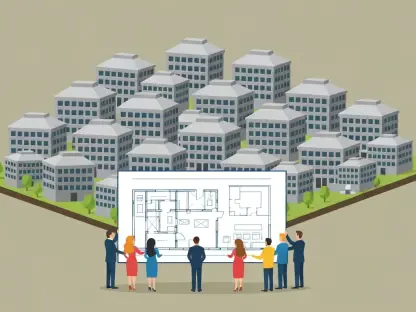In 2025, the global construction industry faces an array of influential economic forces and emerging trends that significantly shape project costs. Amidst this complex environment, inflation, borrowing costs, and geopolitical dynamics arise as pivotal elements intricately intertwined with construction expenses. With the persistence of these factors, industry professionals must adapt their strategies and budgets to navigate uncertainties and shifts in the market effectively.
Economic Influences on Construction Costs
Inflationary Pressures
Enduring inflationary pressures profoundly affect the construction industry, driving up material costs and impacting total project expenditure. This endemic economic issue requires industry actors to recalibrate budget allocations regularly, as persistent price increases ripple through procurement and investment decisions. These pressures demand strategic foresight to mitigate adverse effects on profitability and project feasibility. Strategies for coping with inflation include utilizing advanced forecasting models and engaging in adaptive planning. Contract negotiations often incorporate price escalation clauses to avoid disputes related to inflation-induced changes in cost estimates, fostering smoother project execution.
Borrowing Costs
Borrowing costs continue to be a significant hurdle in construction investments, heavily influencing project viability. High interest rates necessitate innovative financing solutions as traditional lending avenues become less accessible. At this junction, some projects turn to public sector funding or seek alternative financing mechanisms, such as green bonds, particularly for sustainable infrastructure undertakings. Collaboration between financial institutions and construction firms is pivotal in addressing these challenges. Tailored financial products can mitigate financing burdens while accommodating sector-specific needs and fluctuating market conditions. Identifying auxiliary funding sources and leveraging financial technology are critical in overcoming constraints and maintaining momentum within the construction industry.
Geopolitical Dynamics
Geopolitical dynamics continue to weave complex scenarios that disrupt construction costs globally, largely through trade conflicts and tariff implications. Geopolitical tensions impact supply chains, leading to unpredictable project timelines and escalating costs. Companies must engage in diligent risk assessments to buffer against such unpredictable external factors. Proactive strategic partnerships and diversifying supplier networks offer paths to reducing geopolitical risks. Negotiating long-term trading agreements and bolstering regional collaboration can safeguard against sudden disruptions. Furthermore, businesses harnessing geopolitical data analytics provide insights, enabling informed decision-making to mitigate risks and preemptively adapt in a volatile landscape.
Key Regional Insights
United States Market
The United States construction sector showcases a landscape of contrasting signals, primarily driven by public sector investments that prop up growth despite challenges in attracting private contributors. Regional disparities reveal varied market conditions with diverse project demands. The blend of robust infrastructure projects and housing initiatives acts as a catalyst for growth, yet uncertainties surrounding interest rates and material costs continue to impact long-term projections. Adaptation to this dynamic environment requires strategic realignment, with construction companies focusing on technology adoption and resource optimization. Enhancing collaboration between federal and local agencies can foster holistic improvement across construction initiatives, ensuring regional consistency in progress.
European Union Dynamics
Within the European Union, economic challenges cast a shadow over construction growth, catalyzing strategic initiatives in regions such as Germany and Ireland. Infrastructure development and sustainable housing emerge as key areas poised for recovery. Public sector investments in green infrastructure spur optimism, highlighting a shift towards environmentally conscious urban planning. German cities embrace innovative construction methods, while Ireland leverages partnerships to harness technology for sustainable solutions. Managing demographic shifts while accommodating environmental mandates propels construction growth. The European Union continuously evaluates regulatory frameworks to balance modernization needs with traditional practices, broadening outreach and fostering collaboration on emerging trends. Enhanced infrastructure interconnectivity stands as a linchpin for facilitating efficient resource distribution and regional development.
Asia-Pacific Developments
The Asia-Pacific region grapples with a unique set of challenges that influence construction markets and growth trajectories. Australia faces labor shortages that stymie productivity and inflate tender prices. Despite these challenges, the region anticipates growth through large-scale projects centered around transit hubs and Olympic venue preparations. China’s construction sector remains buoyed by government-led initiatives and infrastructure development, amidst fluctuating urbanization dynamics. Sustainability efforts remain paramount as green and smart building projects gain momentum. Internal balancing of labor market mismatches and external opportunities such as global events fuel growth optimism across the Asia-Pacific, promoting technological advancements and modernized approaches in construction methodologies.
Construction Sector Challenges
Labor Market and Workforce Skills
The construction industry confronts enduring labor market challenges, as workforce availability and skill mismatches hamper productivity. To overcome these hurdles, strategic initiatives in workforce development play a critical role in advancing long-term sector evolution. Educational programs tailored to industry needs foster skill enhancement among workers, while collaborative efforts between construction firms and educational institutions aim to bridge the skills gap. Innovative hiring practices provide diverse career pathways, fostering inclusivity and promoting workforce diversity. Technology-driven training platforms emerge as essential tools in equipping workers with the necessary skills, ensuring alignment with modern construction techniques and sustainable practices.
Insolvency Concerns
High rates of insolvency remain a pressing concern for construction firms, highlighting vulnerabilities linked to labor costs and debt servicing obligations. While the UK observes slight improvements, the looming risk of financial distress underscores the need for robust risk management frameworks globally. Deep insights into financial health allow firms to identify early warning signals and pivot accordingly. Collaborative risk mitigation measures and improved fiscal strategies foster resilience, facilitating continuity amidst challenges. Navigating the maze of insolvency requires meticulous capital allocation and prudent financial planning, ensuring long-term stability in volatile economic environments while leveraging transparent communication channels for maintaining investor confidence.
Supply Chain Disruptions
Supply chain disruptions stemming from geopolitical tensions and tariff policies expose vulnerabilities, threatening project timelines and cost management. Efforts to stabilize and diversify source networks emerge as crucial safeguards against potential disruptions. Anticipatory logistical planning and strategic supplier diversification allow firms to maintain competitive pricing strategies and mitigate raw material shortages. Enhanced digital platforms for supply chain management facilitate real-time monitoring and adaptive response mechanisms, ensuring heightened efficiency and resilience. Building robust supplier relationships and establishing alternative supply routes prove essential for enduring adverse impacts, promoting consistency in material availability and seamless project execution.
Prospects and Future Trends
Public Investment and Recovery
Public sector investment stands as a beacon of optimism for recovery in pivotal construction markets, as strategic prioritization mirrors sector evolution. Defense, social infrastructure, and housing projects receive heightened focus, driving resurgence and fostering improved investment climates. A collaborative approach between governmental agencies and industry participants catalyzes progressive initiatives. Emphasizing infrastructure sustainability, the construction sector harnesses advanced technologies for enhancements in resource allocation and environmental efficiency. Public investment emerges as a transformative force reflecting modernity, aligning societal needs with economic aspirations, promoting balanced growth trajectories, and reinforcing construction industry resilience.
Currency and Commodities Impact
Currency fluctuations and commodity price trends impose added complexity on construction cost management, prompting heightened strategic considerations. Energy prices see contractions, providing temporary respite, yet volatility in metals presents challenges to maintaining stable pricing structures. Leveraging financial instruments hedges against currency risks, safeguarding project budgets from abrupt fluctuations. Insight-driven procurement strategies optimize material sourcing, balancing cost-efficiency with operational necessity. Firms adopt dynamic pricing models that account for commodity trends, ensuring adaptive responses to market conditions, promoting foresight in investment planning, and solidifying sustainable cost flows.
Technological Integration
By 2025, the global construction industry finds itself confronting a diverse set of economic forces and emerging trends that prominently influence the cost of projects. This dynamic and challenging landscape is characterized by the prominence of inflation, rising borrowing costs, and fluctuating geopolitical dynamics. Each of these elements plays a crucial role in shaping the financial framework within which construction projects operate. Inflation continually affects material and labor costs, pushing budgets beyond initial estimates. Meanwhile, increased borrowing costs make financing construction projects more expensive, requiring stakeholders to reassess budget allocations and financial strategies. Geopolitical factors, including trade policies and international relations, further complicate the scene by introducing unpredictability in supply chains and material availability. In light of these persistent challenges, professionals within the industry must be agile and innovative, adapting their strategies and financial plans to navigate the unpredictable market landscape effectively. Industry experts are advised to embrace flexibility and forward-thinking approaches, ensuring they can manage uncertainties and shifts efficiently while capitalizing on growth opportunities in the ever-evolving construction environment.









